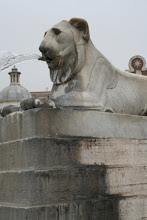Last full day in Rome today.
The day started with the usual light rain, and after
devoting some time to clearing out the fridge of rogue olives, bits of cheese,
wine etc I tackled my packing, having
dashed out yesterday to buy an extra carry-on suitcase. I’m jettisoning some boots and coats too –
the cobbles have been particularly hard on my shoes.
So it’s farewell to Rome again, for six months until Jim and
I return in August. It’s been a mixed
trip – lots of positive language reinforcement (I can speak Italian – yay!), a
LOT of rain, some wonderful catch-ups with language exchange buddies and
classmates, and also quite a bit of time watching Italian news and movies, and
having casual conversations in supermarkets, boutiques, bookstores and the
like.
On Sunday I spent the day in Cerveteri with my language
exchange buddy, Angelo, and we climbed in and out of some very flooded tombs,
watched sound and light shows that magically reconstructed the interior of the Etruscan
burial sites, and stopped for the mandatory espresso half-way through. After three and half hours we had a late lunch
in the dramatic hill top town of Ceri before heading back to Rome at dusk.
.jpg) |
| Tombs at Cerveteri |
As usual, after seven hours of Italian I
found my ear was quite attuned and I was able to speak relatively easily, which
is the great thing about language exchange.
Aside from the very generous people you meet, who are happy to devote
time to arranging trips, researching and providing written information in italian,
and finding great spots for authentic regional food!
.jpg) |
| The town gate at Ceri |
Cerveteri is magical, with around 1,000 tombs spread over
400 hectares – 10 hectares of which can be easily visited. The tombs vary from dice-shaped tombs (so-called
for their regimented and block-like shape – these were for the middle-classes)
to the mounds of the exalted families, both types from around 3rd
century BC. All the objects found inside
the tombs are long gone (of course) but originally there were funerary urns, sarcophagi,
estruscan urns and figurines, and many of these can be seen at the Villa
Giulia, the estruscan museum near the Villa Borghese gardens, and where I
headed this afternoon. Of especial
interest and delight is the Sarcophagus of the Spouses, a life-size sarcophagus
of a couple reclining, as at banquet, with the bridegroom’s arm protectively
around the shoulders of his spouse. Both
are smiling. It’s a very lovely object
to see, and especially today, when I had it to myself. Apart from the guard, of course, who was
hovering to make sure I didn’t take any photographs (the one below is from
Wikipedia).
So last night, a drink with one of my fellow students in
Monti (where I’ve been studying), who is here in Rome with her husband for
three years. We drank red wine from
Lazio, started in Italian and switched to English, and talked about spending
time in Rome, the vagaries of the Italians, and our struggles with the
language.
I walked back to my apartment past the floodlit forums of
Trajan and Nerva, the immense white marble of the Vittorio Emanuele monument,
and through the busy hum of the Campo dei Fiori and Trastevere.
Am I ready to go home?
Yes. I’ve enjoyed my time here,
but I’m really looking forward to getting back to my loved ones. A presto, Roma.
.jpg)



.jpg)

.jpg)
.jpg)
.jpg)








.jpg)


.jpg)
.jpg)
.jpg)

.jpg)
.jpg)
.jpg)
.jpg)
.jpg)





.jpg)
.jpg)
.jpg)
.jpg)
.jpg)










